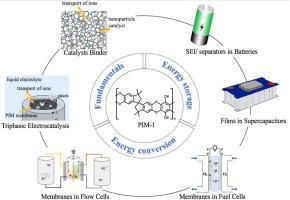Electrochemistry Communications ( IF 4.7 ) Pub Date : 2020-07-24 , DOI: 10.1016/j.elecom.2020.106798
Lina Wang , Yuanzhu Zhao , Bingbing Fan , Mariolino Carta , Richard Malpass-Evans , Neil B. McKeown , Frank Marken

|
Polymers of intrinsic microporosity (or PIMs) have emerged as practical film or membrane materials for a range of electrochemical technologies. Fundamentally, PIMs are based on highly rigid polymer backbone structures, which are inefficient for packing into solid films or structures. Poor packing in the solid is linked directly to (i) good solubility and processability, (ii) to glassy structures with persistent microporosity, (iii) to interesting permeation and separation properties for ions and for neutral molecular species, and (iv) to pore retention during pyrolysis. Further modification by cross-linking, introduction of charged functional groups, and hybrid material formation has been reported for applications in batteries, capacitors, fuel cells, and flow energy storage systems. This mini-review highlights recent applications suggested for PIMs in electrochemical energy systems.
中文翻译:

本征微孔(PIM)膜和膜的聚合物在电化学储能和转化中的作用:迷你综述
具有固有微孔性的聚合物(或PIM)已作为多种电化学技术的实用薄膜或膜材料出现。从根本上说,PIM基于高度刚性的聚合物主链结构,对于包装成固体膜或结构而言效率不高。固体中的填充不良与(i)良好的溶解性和可加工性,(ii)具有持久微孔性的玻璃状结构,(iii)与离子和中性分子的有趣渗透和分离特性以及(iv)与孔隙有关在热解过程中保留。据报道,通过交联,引入带电官能团和形成杂化材料的进一步修饰可用于电池,电容器,燃料电池和流动能量存储系统中。































 京公网安备 11010802027423号
京公网安备 11010802027423号